Chapter 4.
ST.ANDREW THE FIRST CALLED, WHO BAPTISED RUSSIA IS ANOTHER REFLECTION OF JESUS CHRIST WHO PREACHED IN THE XII CENTURY, AND LIVED AND RULED IN RUSSIA FOR THE MOST PART OF HIS LIFE.
1. THE SCALIGERIAN VERSION OF APOSTLE ANDREW’S LIFE.
Perhaps St.ANDREW the Apostle, who baptized Russia allegedly in the I century is, like ANDREI Bogolyubskiy, another reflection of Jesus Christ of the XII century on the pages of the old documents.
It is believed that St. Andrew the Apostle of Jesus Christ was a brother of the Apostle Peter and worked together with him in Capernaum on the Sea of Galilee, fishing, when Jesus asked him to follow Him (Matthew 4:18). According to the Gospel of John he was one of the disciples of John the Baptist and was called by Jesus on the banks of the Jordan even earlier than Peter (John 1:40-41).
The Brockhaus and Efron Encyclopaedia reports: ‘For that reason according to the Greek legend he bears the name of the ‘FIRST-called’. According to the Holy Gospels he, together with his brother and the two sons of Zebedee, was among CHRIST’S CLOSEST DISCIPLES. According to the church tradition together with his brother he preached Christianity to the ‘Scythians’, i.e. the people living on the South, East and North-East shores of the Black Sea. According to the Russian chronicles he preached in Old Russia, travelled near to today’s Kiev, where he erected a cross, reached Novgorod and the village of Gruziny, where he erected his cross … From the shores of the Pontus he crossed the Propontis and reached Thrace and Greece and WAS CRUCIFIED in Patras by order of the proconsul Aegeates … The legend ascribed to him about being nailed to a slanting X shaped cross (St.Andrew’s cross) is of very late origin. Besides Russia, Scotland also venerates this apostle as the patron of their country. In both these countries the order of St.Andrew was established in his honour’ [154].
The Russian chronicles which survived in the late Romanov edition do not say much of the baptizing of Russia by St.Andrew, but they say it quite clearly. We will cite the translation by V.N.Tatishev in a more modern language: ‘Dnieper flows into Pontic Sea via the three mouths of the river, and this sea goes by the name of the Russian (Sea – Tr.), they say that the Holy Apostle Andrew the brother of Peter was preaching there. When preaching in Sinop, Andrew went to Korsun (today this ‘ancient’ city is identified with Khersones Tavriysky in Crimea, see [101], book 1, p.64 – Author) and seeing that nearby was the mouth of the river Dnieper, HE WILLED TO GO TO ROME, and having arrived at the mouth of the river Dnieper, HE HENCE WENT UP THE DNIEPER and found himself on the shore in the shadow of the mountains. When he rose in the morning he said to his disciples: ‘Do you see these mountains? You should know that upon these mountains there will stand a great city and many churches will be built’. Having ascended these mountains and having blessed them, he prayed God with tears in his eyes. These are the very mountains where later Kiev was built. HENCE ANDREY WENT TO ROME ITSELF. When he came to the Slavs, where at present Novgorod stands, and seeing the customs of its people, as they wash and steam-bathe in bath-houses, he marvelled at them. Hence he went to the Varyangians and to Rome, where he told how much he preached and what he saw. Then from Rome he returned to Sinop again’ [130], v.2, p.7-8.
The Nikon Chronicle specifies that Andrey ‘RAISED A CROSS’ (PUT A CROSS) on the Dnieper mountains [102], v.9, p.4. Fig.4.1 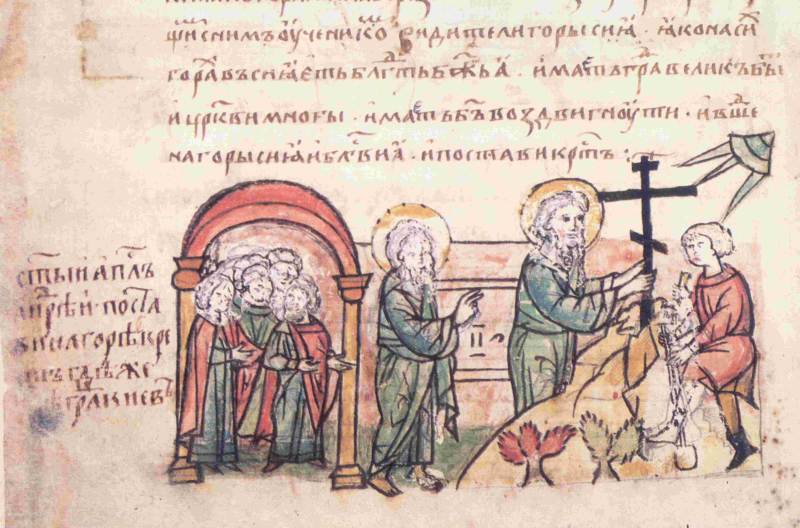 presents a miniature from the Radziwiłł Chronicle ‘Apostle Andrei raises a cross on the Kiev Mountains’.
presents a miniature from the Radziwiłł Chronicle ‘Apostle Andrei raises a cross on the Kiev Mountains’.
By the way, in regards to the Slavic washing in the bath-houses the following words of St.Andrew are being cited: ‘IT IS WONDROUS TO SEE in the land of the Slavs, the wooden bath-houses with many stones inside them, and these stones are red hot, and then rye beer (kvass – mildly alcoholic drink made from fermented rye bread) poured over them, and they beat themselves with the twigs until they are hardly alive, and then pour cold water over themselves to come back to life; and thus they do every day and torture themselves’ [102], v.9, p.4. It seems that at that time the culture of washing in the bath-houses was not yet spread from Russia over the other lands, and therefore Andrei who had arrived from Czar-Grad paid a particular attention to such a useful custom. Probably with the purpose to introduce it to more southerly countries from which came himself. It is stated for the reason that ‘a custom of the Novgorodian Slavs to bathe in the bath-houses seemed to be a great curiosity to their southern fellow-countrymen’ [89], book 1, p.267. We talk in detail about the custom of washing hands before eating and bathing in the bath-houses for instance in the Western Europe which began much later in ‘Imperia’ (‘The Empire’) and in CHRON5, ch.12:4.4. However in the Romanov epoch there was created and enrooted a propaganda myth about ‘dirty Russia being eternally behind’ the exquisite West. As a result they made everyone believe that allegedly the ‘Ancient Romans’ bathed in the bath-houses a long-long time ago, in the primordial times. Purporting it happened long before the appearance of the Slavs.
From such a reformist point of view the old fragment about the Russians bathing in the bath-houses before ‘the Ancient Romans’ (cited above), was subsequently perceived by the Russian authors themselves with some kind of unease. As if it made them somewhat awkward in front of the enlightened West, see fig.4.2  . No wonder that even Metropolitan Macarius with some kind of embarrassment writes the following: ‘We agree that there is a small oddity in the narrative by our chronicler where he reports that purportedly St.Andrew was to such an extent interested in a custom of the Novgorodian Slavs to bathe in the bath-houses’ [89], book 1, p.97.
. No wonder that even Metropolitan Macarius with some kind of embarrassment writes the following: ‘We agree that there is a small oddity in the narrative by our chronicler where he reports that purportedly St.Andrew was to such an extent interested in a custom of the Novgorodian Slavs to bathe in the bath-houses’ [89], book 1, p.97.
But let us leave the topic of the hygiene alone as an obviously secondary one and return to the more important subject.
2. A SALTIRE (DIAGONAL CROSS OF ANDREW) ON WHICH ST.ANDREW WAS CRUCIFIED.
Perhaps the evangelical name the FIRST CALLED (PROTOCLETOS) originally meant the following. As Christ was THE FIRST CALLED upon by Lord to fulfil the Divine Mission. But later when more recent chroniclers ‘multiplied’ Jesus into several characters, each of them acquired their own written biography slightly different from the original and partially distorted. Andrei-Christ was called (on paper!) an Apostle of Christ. And his sobriquet – FIRST CALLED by God – was interpreted in that evasive sense that purportedly he was summoned FIRST by Christ.
The report about St Andrew being CRUCIFIED by the order of proconsul Eges (or Aegeates) also becomes clear. As Jesus Christ was indeed CRUCIFIED by the order of the prefect (Pilates). St. Hippolytus Bishop of Portus wrote allegedly circa 222 that ‘After preaching to the Scythians and Thracians Andrew suffered Death on the Cross in Patras in Achaea by being crucified on the olive tree and was also buried there’ cit.ex [89], v.1, p.92. In accordance with our results Jesus Christ was crucified in Czar-Grad, therefore by ‘Patras in Achaea’ they meant Czar-Grad. It is worthy noting that Andrew is one of the few apostles of Christ whose death is consistently associated with the CROSS for crucifixion. This circumstance is common for the later literary testimonials about Andrew and about Christ. Probably in order to slightly blur such an obvious correspondence, the more recent editors decided to slightly change ‘the cross of Andrew’ and began to describe it as a saltire (sidelong cross), allegedly unlike the cross of Jesus Christ, see fig. 4.3 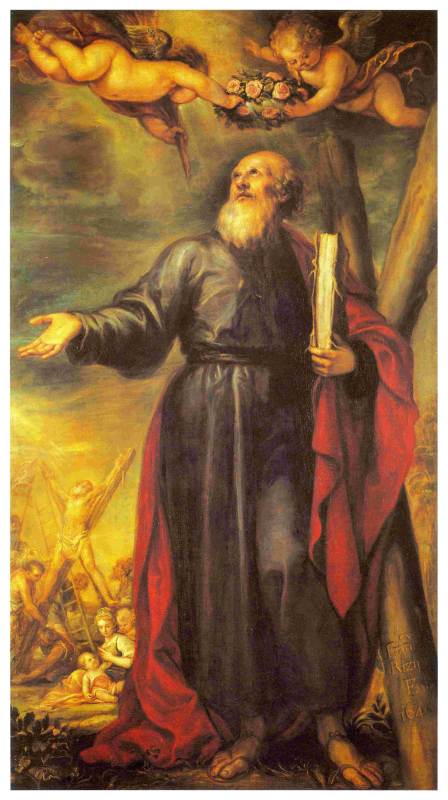 and fig. 4.4
and fig. 4.4  . Since then such saltire was called (St.) Andrew’s cross. And the artists began to obediently paint a sidelong cross ‘for Andrew’.
. Since then such saltire was called (St.) Andrew’s cross. And the artists began to obediently paint a sidelong cross ‘for Andrew’.
It should also be noted that one of the forms of the old Christian cross looks like the Latin letter Y and is called a forked cross, see [PAP] and CHRON4, ch.6. Up until the XIX century in some churches
Christ’s crucifixion was depicted on exactly such a forked cross, see [РЕК] и CHRON7, ch.18. But such a form of cross strongly resembles St.Andrew’s saltire. So most likely St.Andrew’s saltire is simply one of the old forms of the Christian fork-shaped cross Y. Besides there survived the old images where the resurrected Christ is shown standing on the LONG SIDE (SALTIRE) cross, see for example fig.4.5 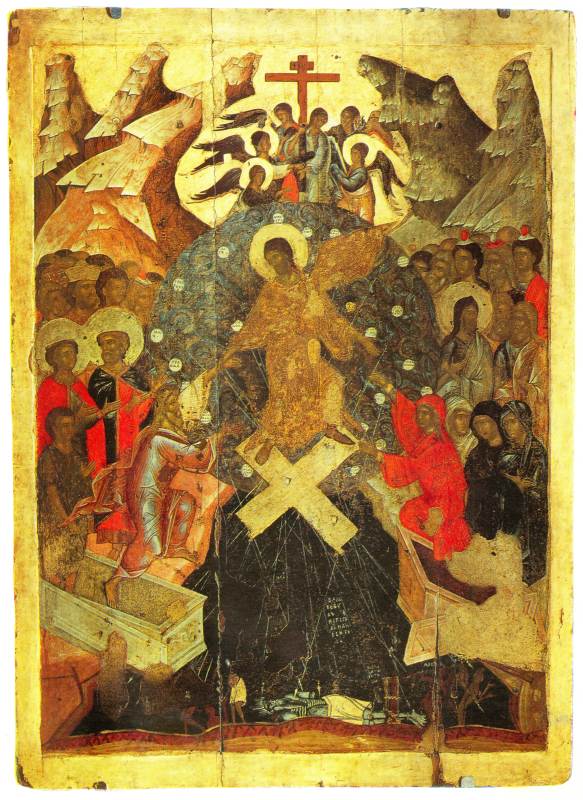 and fig.4.6
and fig.4.6  . Sometimes it was believed that such a cross was formed with the broken doors of hell, where Christ descended to.
. Sometimes it was believed that such a cross was formed with the broken doors of hell, where Christ descended to.
At the same time some of the mediaeval artists depicted Andrew the First Called near the usual cross, see for example fig.4.7 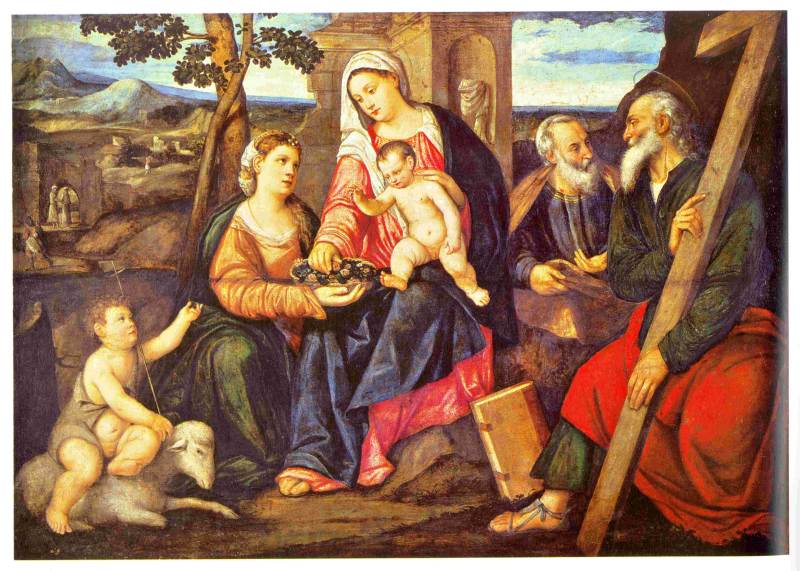 , fig.4.8
, fig.4.8 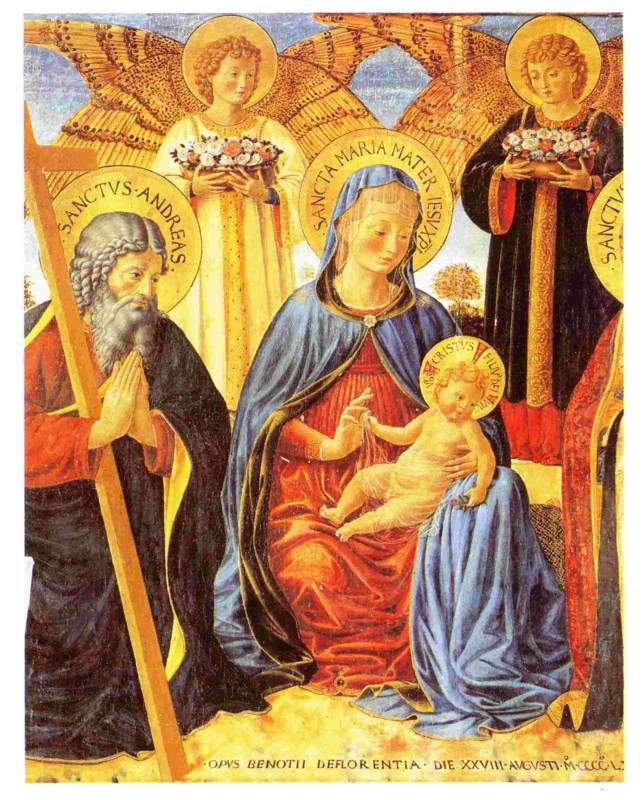 . Here is shown a tall cross with a short bar on the top, i.e. the same kind of cross which crucified Christ is usually depicted on. It is possible that as early as in the XVI century there survived a tradition which identified Andrew the First Called as Christ.
. Here is shown a tall cross with a short bar on the top, i.e. the same kind of cross which crucified Christ is usually depicted on. It is possible that as early as in the XVI century there survived a tradition which identified Andrew the First Called as Christ.
3. ST.ANDREW CAME TO RUSSIA AND BAPTISED THE SLAVS.
We shall note that St.Andrew when entering the mouth of river Dnieper and going UP THE RIVER moved, as we were told, towards Rome. Have a look at the map. Provided that ‘Ancient Rome’ occupies its Scaligerian place in modern Italy then the direction of Andrew’s movement is at the very least strange. It looks like while wishing to get to the Italian Rome he was moving IN THE OPPOSITE DIRECTION, moving away from Italy. Our reconstruction puts everything in its place. The authors of the chronicles still remembered that ‘Ancient Rome’ was Russia-Horde of the XIV-XVI cc., and therefore entirely rightfully pointed out that St.Andrew’s journey to Russia (in the XII century) was the movement specifically towards Rome. So everything is correct here. The corresponding text by V.N.Tatishev gives the additional reasons for such an idea. Judge for yourself! V.N.Tatishev presents the old chronicles in the following way: ‘Andrew … came to Korsun and after seeing the mouth of river Dnieper nearby WISHED TO GO TO ROME, AND HAVING ARRIVED AT THE MOUTH OF RIVER DNIEPER WENT UP DNIEPER and occasionally stopped under the mountains on the shore … These are the exact mountains where Kiev was later built. HENCE ANDREW TRAVELLED UP TO ROME. REACHING THE SLAVS, WHERE NOVGOROD NOW STANDS …FROM THERE HE WENT TO THE VRANGIANS AND TO ROME … FROM ROME he returned to Sinop again’ [130], v.2, p.7-8. Quite clearly here is given the description of St.Andrew’s journey from the mouth of river Dnieper up the river and then more to the North, to Central Russia, which was called Rome.
Many old authors (if you understand their words literally, and not in the way which many commentators interpret them) speak of St.Andrew not only baptising Russia, but also RULING it. For example famous Origen, who lived allegedly in 200-258, claimed that St.Andrew not just visited Scythia and preached there, but RECEIVED SCYTHIA AS HIS LAND, i.e. as we understand it now, he ruled there [89], book 1, p.92. We see that ‘classic’ Origen was absolutely right. During his visit to Scythia=Russia Jesus Christ, aka the Grand Prince Andrey Bogolyubskiy indeed RULED RUSSIA in the XII century. And not figuratively, but literally. Both religious and secular.
St.Eucherius, bishop of Lyon reports the same allegedly in 449 [89], book 1, p.93.
St.Dorotheus (allegedly 307-322) adds that St.Andrew was for some time in the city of Sevast, which is identified with contemporary Sevastopol [89], book 1, p.92.
The Church Father of Cyprus, Bishop Epiphanius of Salamis (died allegedly in 403) also reported that St.Andrew preached in Sarmatia [89], book 1, p.93. That is, as we understand it now, the very same Scythia = Russia, see book ‘Imperia’ (‘The Empire’) and CHRON5.
Isidorus Hispalensis (allegedly of 570-636) claimed that St.Andrew <<INHERITED THE LAND OF SCYTHIA TOGETHER WITH ACHAIA … Rather remarkable is the account given by Nicetas of Pathlagonia (died in 973) … He says: ‘You, most esteemed Andrew, WHO INHERITED THE NORTH, you zealously got around the Uar, the Sarmatians, the Tauri and the Scythians and followed through all the regions and the cities ADJACENT FROM THE NORTH AND THE SOUTH TO PONTOS EUXEINOS (i.e. the Black sea – Author)’ >> [89], book 1, p.93.
Metropolitan Macarius reports the following: ‘In regards to Holy Apostle Andrew there existed the written legends very similar to that passed on to us by a chronicler, this can be vouched for to some extent by the Ancient Greek manuscript housed in one of the Oxford libraries, from which a small extract was published about St.Andrew’s travels to the land of anthropophagi, or cannibals, perceived by the ancient geographers to be situated in the depth of Russia (Caroli Christi. Woog. Presbyterorum et diaconorum Achaiae De martyrio S.Andreae epistol. 401-414. Lips., 1749" [89], book 1, p.96. See the detailed ref. [184].
It turns out that Nicephorus Callistus in the XIV century says the same thing. We quote: ‘We read in Callistus that St.Andrew with his preaching reached the countries of the anthropophagi and the DESERTS OF SCYTHIA’ [89], book 1, p.96.
Moreover, it turns out St.Andrew also baptised Poland. Metropolitan Macarius reports: <<We cannot but recall here the legend about Holy Apostle Andrew that he preached IN POLAND… (Pagi. 4. p.10, under year 965; Lubinsk in the Lives of the Bishops of Polotsk. “Istoria pervoy tserkvi u Slavyan” (‘History of the Slavs’ first Church’) by Matseevskiy in the Russian translation. P.109 and 223. Warsaw, 1840) (Паги. 4. С.10, под 965 г.; Лубинск. в Жизнеописании Полоцких епископов. "Истор. перв. Церкви у славян" Мацеевского в русс. перев. С.109 и 223. Варшав., 1840) >> [89], book1, p.97 and p.266. See the detailed references: [93] and [176]. For a Scaligerian historian ‘it goes without saying’ that St.Andrew’s preaching in the Ist century in Poland is out of the question. But from the New Chronology point of view there is nothing strange about it. It would have been strange otherwise, if Slavic Poland remained on the sidelines from Russia’s baptism by St.Andrew. It is reported that St.Andrew had some disciples in Scythia: <<In the ancient calendars, or Synaxarions, under the 20th January we can find the following short tale about the Holy Martyrs Enena, Nirina and Pina (or Inna, Pinna and Rimma) : these saints were from Scythia, from the North country, the disciples of Apostle Andrew. They preached about the name of Christ, and they converted many barbarians into the true Christian faith, and were baptising… THERE WAS A SEVERE WINTER AND ALL THE RIVERS FROZE UP SO MUCH THAT NOT ONLY PEOPLE BUT HORSES AND BULLS ALSO WALKED ON THE ICE. The prince ordered the placement of large trees on the ice as if attached by their roots …>> [89], book 1, p.103. Hence it clearly follows that they refer to the Northern regions of Russia. Metropolitan Macarius rightly comments on the rather detailed text of the ancient calendar mesyatseslov: ‘This severe winter, this bitter cold freezing all the rivers to such an extent that it inadvertently suggests that the action took place most likely here, possibly somewhere by the Kiev mountains, rather than beyond Danube by the Balkan mountains’ [89], book 1, p.103. It is possible that the described events unfolded even more to the North than Kiev region, as THE SEVERE WINTER is referred to. Fig.4.9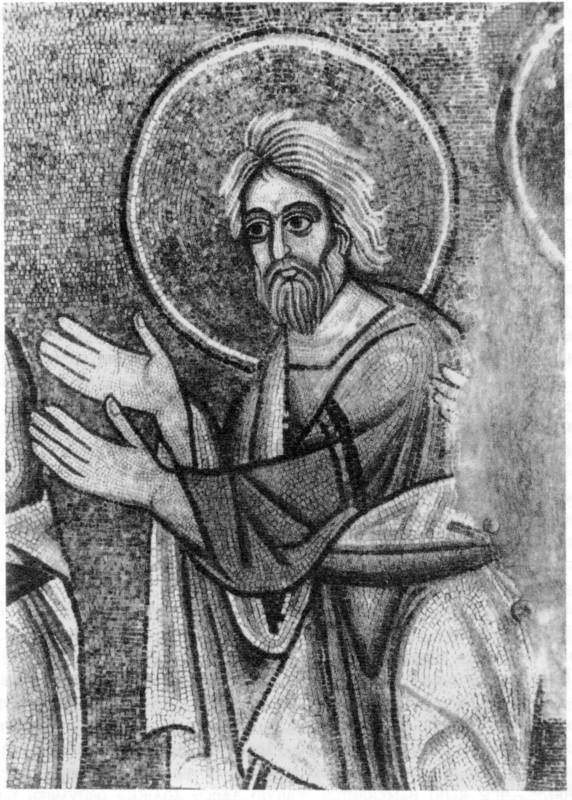 presents an old Russian mosaic depicting St.Andrew. The mosaic is situated in the Kiev’s Saint Sophia Cathedral ( Hagia Sophia).
presents an old Russian mosaic depicting St.Andrew. The mosaic is situated in the Kiev’s Saint Sophia Cathedral ( Hagia Sophia).
It is being dated to the second quarter of the XI century [89], book 1, p.94. It is worth noting that St.Andrew, aka Jesus Christ, is presented here as an elderly man with long grey hair. This corresponds well with the fact that Andrei Bogolyubskiy lived till his senior years and died at the age of 63 or 65, see above. The Gospels also contain the statements that various authors estimated Christ’s age as either 33 or around 50 years old: ‘You are not yet 50 years old’ (John 8:57). This also corresponds well with ‘Niketas of Paphlagon words about Apostle Andrew: … ‘The man, blessed by longevity and length of life, accomplished the work of Christ and HAVING REACHED THE GREAT AGE wished to release himself from his fatigued body ’>>. Cit.ex [89], book 1, p.267.
In the very same Kiev’s Saint Sophia Cathedral there is a mosaic of Jesus Christ in which he is depicted as an OLD MAN. The mosaic is signed with: IC XC, i.e. Jesus Christ. This means that such ‘elderly depictions’ of Christ existed, though very few of them survive.
Besides, the Gospels say that Jesus was a carpenter’s son or a carpenter: ‘Is not this the carpenter's son?’ (Matthew 13:55) and further: ‘Is this not the carpenter, the Son of Mary’ (Mark 6:3). But in this case in the Gospels’ Palestine the carpenter as a profession did exist. There was a lot of wood and hence a lot of forests. But in contemporary Palestine nothing of the kind exists. The main building materials were stones, clay, etc. In fact there is no contradiction here. As we showed earlier some of the Gospel events took place in Russia. In Russia there is indeed a lot of forest wood and therefore there are carpenters. They built wooden houses, wooden churches, etc.
To conclude. As we see many Mediaeval authors who wrote, as it becomes clear now, in the epoch of the XIII-XVI cc. directly pointed out that St.Andrew for some time RULED AND PREACHED IN THE NORTH of the Black Sea, in Scythia=Sarmatia.
4. SCALIGERIAN HISTORIANS DECLARE MANY FACTS FROM ST.ANDREW’S LIFE TO BE FANTASTICAL.
It must be said that the chronicle’s information about the baptism of Russia by St.Andrew, which was previously received with full confidence and respect, later, beginning with the XVIII century incited a rather negative reaction in many Romanov and West European historians. In fact let us turn our attention to the following: ‘Already in the end of the XVIII c. the historians represented by Schlozer began to express doubt in the authenticity of this chronicle legend, not troubling themselves much with any line of reasoning’ [89], v.1, p.37. See ‘Imperia’ (‘The Empire’) and CHRON4, ch.1:2 about the leading and rather tendentious role of the German ‘experts’ in creating the Romanov version of Russian history, in particular about the role of Schlozer and Miller. For example Shlozer was assuring the public: ‘Nestor’s legend about Apostle Andrew’s travel is nothing but a religious fable’. Cit.ex [89], v.1, p.37, comm. (commentary) 1. Scornfully suggesting: ‘There is no need to prove that the events described here do not belong to the historical facts’ (L.Muller Old Russian legend about Apostle Andrew travel to Kiev and Novorod), [89], book 1, p.39. Let’s ask ourselves here, why beginning with the XVIII century some historians assure us so fervently that the ancient authors ‘had invented all of this’? We shall answer. That is because beginning with the XVIII century the false chronology was firmly established, whereas the legend about Apostle Andrew found himself in the I century and the Slavs who he ruled and baptised appeared in the historical arena considerably later, not earlier than the IX-X cc. Thus a huge chronological gap was made. In order to smooth down and conceal the contradiction which they had themselves created, the historians began to assure themselves and the others that allegedly Andrew’s rule in Russia was a fairy-tale. They continue to repeat that to this day.
Formal Informal Moreover, THE GENERAL TREND’ prevailing in contemporary literature – is COMPLETE DENIAL of the authenticity of the chronicles legend about Apostle Andrew visiting the lands of Kiev and Novgorod, and by default, the Northern shores of the Black Sea, i.e. the Kingdom of Bosphorus), Chersonesus, Olbia and other ancient cities; sometimes it comes to denial Apostle Andrew ever visited Byzantium, the future Constantinople as well’ [89], v.1, p.37-38.
At the same time they often pretend that only the Russian chronicles speak about the baptism of Russia by Andrew. Purporting that the Slavic chroniclers especially ‘raised the status of Ancient Russia’ for opportunistic and ideological reasons, invented the ‘beautiful antiquity’ [89], book 1, see 39. But at the same time they carefully draw a veil over the indisputable fact that there are many more statements in support of St. Andrew’s stay in Russia=Scythia surviving in the texts of the ‘early Mediaeval’ authors who lived far from Russia, namely in Greece, Italy, in the Mediterranean.